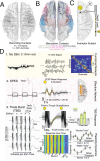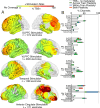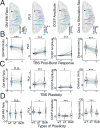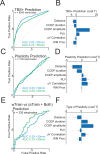Theta-burst direct electrical stimulation remodels human brain networks
- PMID: 39143083
- PMCID: PMC11324911
- DOI: 10.1038/s41467-024-51443-1
Theta-burst direct electrical stimulation remodels human brain networks
Abstract
Theta-burst stimulation (TBS), a patterned brain stimulation technique that mimics rhythmic bursts of 3-8 Hz endogenous brain rhythms, has emerged as a promising therapeutic approach for treating a wide range of brain disorders, though the neural mechanism of TBS action remains poorly understood. We investigated the neural effects of TBS using intracranial EEG (iEEG) in 10 pre-surgical epilepsy participants undergoing intracranial monitoring. Here we show that individual bursts of direct electrical TBS at 29 frontal and temporal sites evoked strong neural responses spanning broad cortical regions. These responses exhibited dynamic local field potential voltage changes over the course of stimulation presentations, including either increasing or decreasing responses, suggestive of short-term plasticity. Stronger stimulation augmented the mean TBS response amplitude and spread with more recording sites demonstrating short-term plasticity. TBS responses were stimulation site-specific with stronger TBS responses observed in regions with strong baseline stimulation effective (cortico-cortical evoked potentials) and functional (low frequency phase locking) connectivity. Further, we could use these measures to predict stable and varying (e.g. short-term plasticity) TBS response locations. Future work may integrate pre-treatment connectivity alongside other biophysical factors to personalize stimulation parameters, thereby optimizing induction of neuroplasticity within disease-relevant brain networks.
© 2024. The Author(s).
Conflict of interest statement
None of the authors have conflicts of interest to disclose in relationship with the current work.
Figures








References
MeSH terms
Grants and funding
LinkOut - more resources
Full Text Sources

